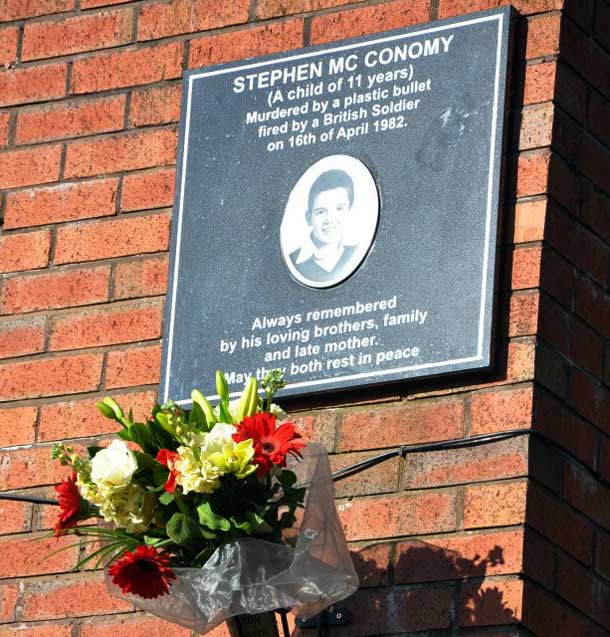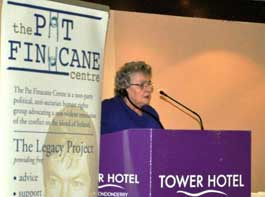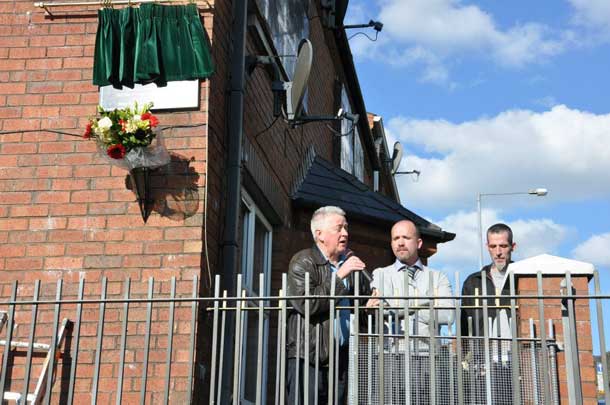24 April 2012
Derry remembers Stephen McConomy (11), killed by a British Army plastic bullet

Stephen was one of 18 deaths (mainly of children) killed by plastic baton rounds and no British soldier or member of the RUC, to this day, has ever been prosecuted
TWO HUNDRED PEOPLE gathered in Derry’s Bogside on Thursday 19 April to remember 11-year-old schoolboy Stephen McConomy, who was shot dead by the British Army 30 years ago.
Stephen’s brothers, Mark and Emmet, unveiled a plaque on Fahan Street, near where a British soldier from the Royal Anglian Regiment shot Stephen in the head with a plastic bullet. Paul O’Connor of the Pat Finucane Centre chaired the ceremony.
Afterwards, the crowd attended an event in the nearby Tower Hotel where former Sinn Féin Assembly member Mary Nelis delivered a speech calling for justice for Stephen and support for his family’s campaign.
The McConomy family have been working with the Pat Finucane Centre to enage with the Historical Enquiries Team as part of their campaign for get justice for the schoolboy’s death. Stephen’s brother has called for a fresh inquest to be held into the case as part of the campaign.
The following is what Mary Nelis said.

LAST YEAR, during five days of rioting, looting, arson in various cities throughout England which left five people dead, hundreds injured and damage to property amounting to millions of pounds, there wasn’t one plastic baton round fired. During the course of the past 40 years, thousands of plastic and rubber baton rounds were fired by the British Army and the police in the North of Ireland.
We are here tonight to remember Stephen, a child of Derry who was murdered under the shadow of Derry’s Walls, watched by the soldiers who took his life and by the cameras on the look-out posts situated beside the British Army base. We are here tonight to seek justice for Stephen.
Thirty years ago, on that bright sunny April evening, there were no riots, looting or arson – just a group of children playing near their homes in the Bogside.
The quiet of that April evening was broken by the distinctive sound of the firing of a plastic-bullet gun and the life of this child of the Bogside ended as a plastic baton round, fired by a British soldier, found its mark in the skull of this small 11-year-old. His head was cracked open, causing massive brain damage. Such was the force and the speed of the deadly plastic bullet that it lifted the small body of Stephen McConomy several feet off the ground. He never regained consciousness.
The soldiers present would later claim that they issued a warning at a youth carrying a box before firing a baton round. These lies would be exposed by the evidence of witnesses and by the coroner’s conclusion at the inquest a year later. There was no danger to soldiers or anyone else from Stephen and his friends on that April evening. Their ‘crime’ was that they were Irish children playing in their own city and, in the eyes of the British Army, they were expendable.
The soldier who fired the plastic baton round which took the life of this wee child would have known its lethal potential but would have surmised that, whatever the circumstances, the likelihood of his being held accountable for firing a weapon that would kill an innocent Irish child would never happen. He was right. The RUC promised an urgent investigation into the murder of Stephen but, in 1982, the Director of Public Prosecutions announced there would be no prosecutions of the soldiers involved.
Stephen was one of 18 deaths (mainly of children) killed by plastic baton rounds and no British soldier or member of the RUC, to this day, has ever been prosecuted.
The plastic baton round with its forerunner, the rubber bullet, was introduced into the North as a weapon of ‘minimum force for riot control’. It was, in effect, a weapon of mass destruction in the hands of its users. In addition to those killed, the firing of plastic baton rounds have caused thousands of horrific injuries, including brain damage, blindness, paralysis, fractures, facial disfigurements, internal organ damage and the loss of limbs. The extent of such injuries and the pain and damage they have caused to human beings in nationalist communities has never really been calculated.
Public attention to the horrors of such damage was, to a small extent, shown in the photograph of the bloody face of the late Emma Groves. In 1971, Emma, the mother of 11 children, was hit in the face by a rubber bullet fired through her kitchen window by a soldier as she stood washing dishes. She would never see her children again. Her eldest daughter described the scene that day:
“There was a bang and my mother fell against the sink. Her face was blown off and there was blood everywhere.”
Emma Groves survived and used her blindness to campaign with Clara O’Reilly to set up a campaign group to have rubber and plastic bullets banned.
Despite this high-profile campaign and the publicity and public outcry, especially around the deaths of children, some 29,000 plastic baton rounds were fired between the years 1973 and 1980. During the major demonstrations in support of the H-Blocks protests and the Hunger Strikers they were used extensively against those who, since 1972, dared once more to protest on the streets.
In 1981 alone, in the month after the death of Bobby Sands, an incredible 16,665 baton rounds were fired.
Many of us present here tonight will recall trying to bury our dead IRA Volunteers under a barrage of plastic bullet rounds. And many of us will also recall the murder of Seán Downes, shot at close range by a plastic baton round fired by the RUC during a peaceful demonstration in west Belfast. In front of the world’s press and television cameras, the RUC waded into the crowd, indiscriminately firing plastic baton rounds, killing 22-year-old Seán Downes and wounding hundreds of others. Like the soldier who fired indiscriminately at Stephen McConomy, the RUC knew they would not be made amenable, even though their actions were flashed around the world.
At a time when this community is working to create an equitable system of policing and justice, there should be no place for such a lethal weapon. Yet we know that the British some years ago developed a new and more forceful plastic bullet, fancifully named the ‘Attenuated Energy Projectile’ (AEP) and costing some £2million pounds. Some 22,000 were purchased by the PSNI. Whatever fancy name the British Government gives this deadly weapon, we are certain of two facts: it will still maim and kill and it will not be used in England.
Thirty years ago and shortly after Stephen died, I wrote a few words to honour this wee child of Derry.
“Every child is born with a message to deliver to the human race: a few words, maybe a picture they paint, or a drawing or a bit of carpentry. Something they will say or do to complete the explanation of why they are here. No child is born to die the victim of plastic technology when it is used to kill. Stephen McConomy delivered his message of existence in blood, within the shadows of Derry’s Walls.”
We should honour his memory today by reiterating our call for the banning of plastic bullets. We should demand that the PSNI put their arsenal of plastic bullets beyond use. Perhaps we should think about naming the day he died as Stephen’s Day.

Mark and Emmet McConomy with Paul O’Connor of Pat Finucane Centre at the unveiling of the plaque to Stephen. The plaque was erected with the help of the local Bogside & Brandywell Monument Committee
Follow us on Facebook
An Phoblacht on Twitter
Uncomfortable Conversations

An initiative for dialogue
for reconciliation
— — — — — — —
Contributions from key figures in the churches, academia and wider civic society as well as senior republican figures




